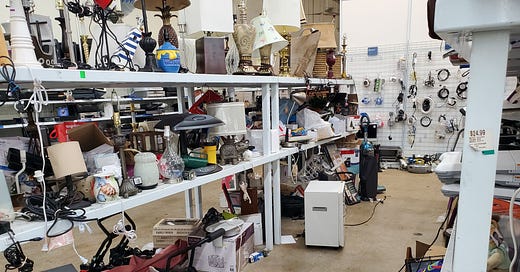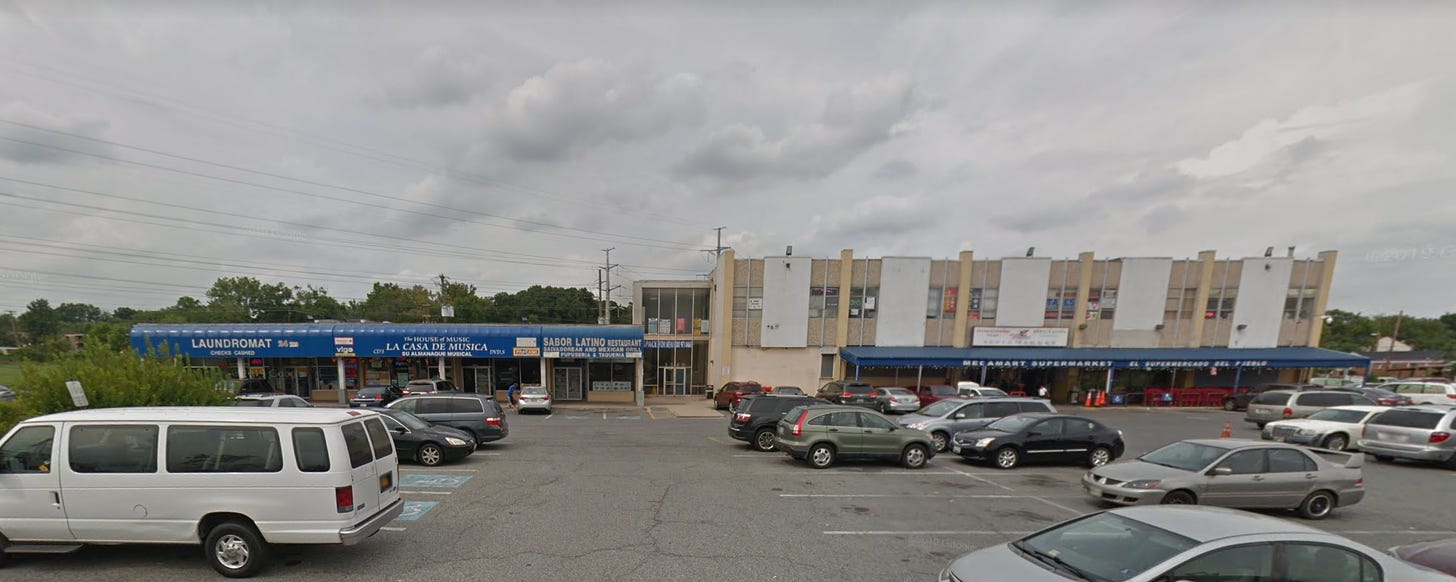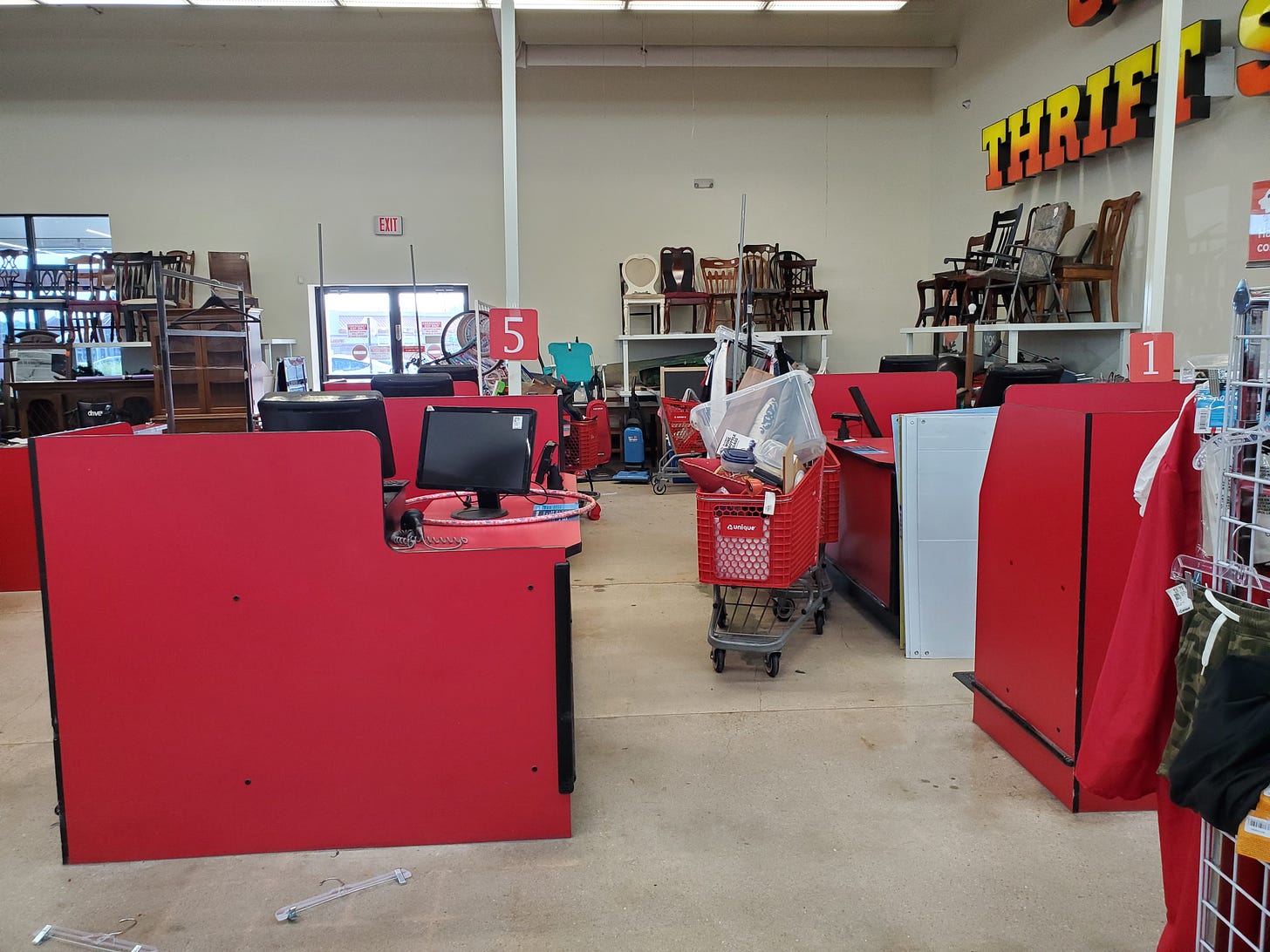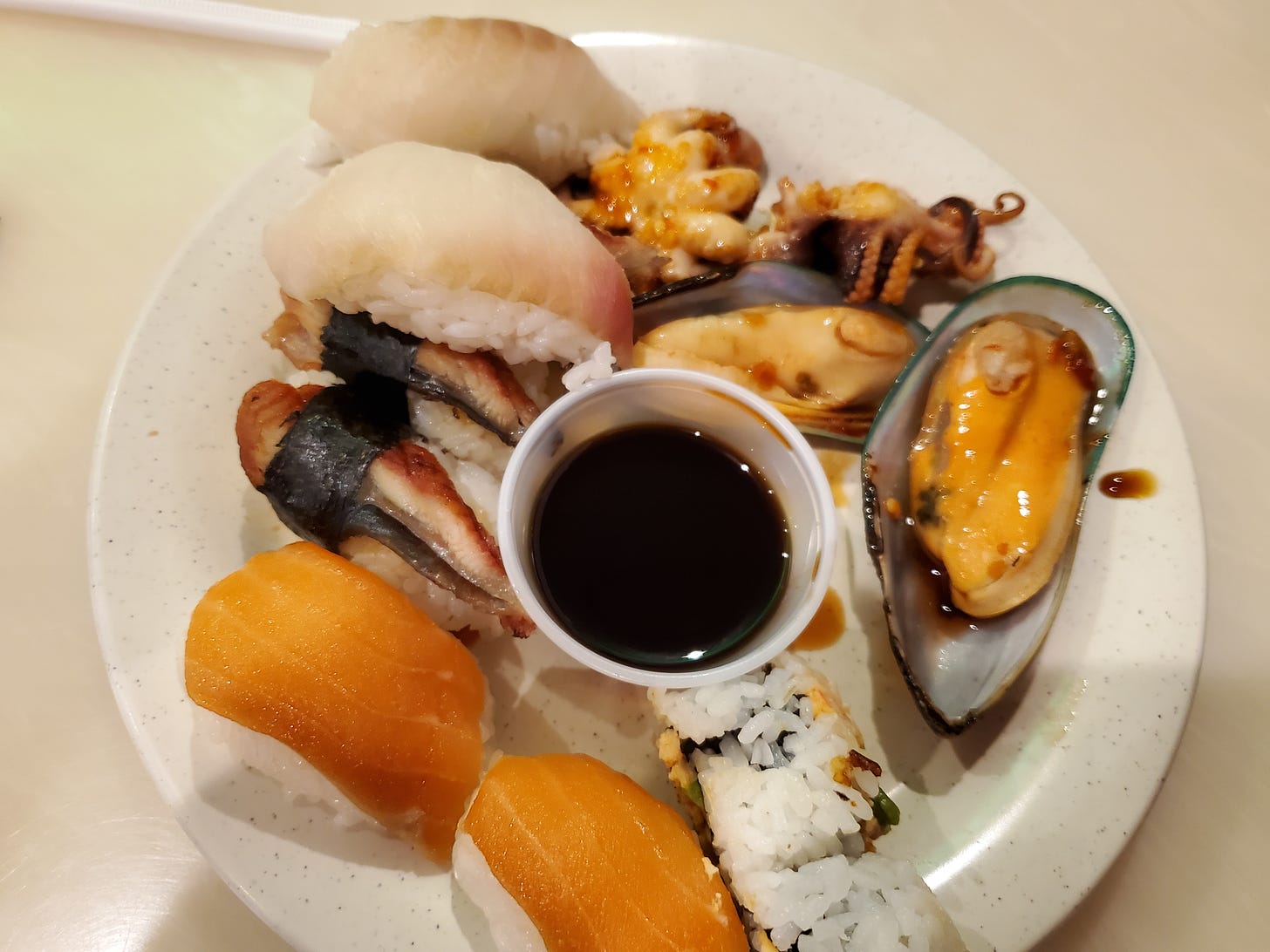I spent a day recently driving around Prince George’s County, in Maryland. I met a friend I made through the University of Maryland’s mentor program, who wrapped up her public policy degree last May, just as I did several years ago. We had a final meet-up before she flies back to her home country for a job she’s already started remotely. (I was employed pretty quickly upon graduation too; the UMD School of Public Policy is pretty good, you know.)
We met at a little coffee shop in front of my old student apartment building; turns out I wrote about the coffee shop in this newsletter once! Then I hit a few thrift stores—the same ones I used to visit on slow school days—except the one that was demolished a few years ago. And I wrapped up by having dinner at a Chinese buffet in Lanham. Back when I lived in College Park and it was only a 12-minute drive on the Beltway—though I kind of preferred the longer drive through neighborhoods and old commercial strips—it was my favorite buffet.
It was in the first year of my master’s program that I started doing this. It was the first year I owned a car and lived far from my parents, too. At that age, for everything to be new or for the first time, it all really made an impression on me. To this day, as you can see, I occasionally spend a day out here, not reliving my grad school days per se, but reminding myself that I’m not old, and enjoying those memories again. It isn’t dating or socializing or classes I miss as much as that feeling of effortlessly leaving the apartment and going anywhere I wanted, most of it within a 10-15 minute drive.
It’s a funny thing; going back to my little college town in New Jersey doesn’t spark any of this. My college friends and I all feel that we enjoyed that time, but we’re glad it’s over and don’t miss it. Grad school, when we had the security of school but the freedom of genuinely being adults? I think we sort of miss that.
But anyway. Over the years, these little trips—interrupted, of course, by the pandemic—have become a little less similar to the original ones. I no longer feel like I’m doing it; I feel like I’m reenacting it. Or trying to. These communities I drive through, some of the poorer suburban places that were mostly built out in the 1950s and 1960s, always looked a bit distressed and timeworn. But that impression, vaguely, has gotten worse.
I did a segment on this in Friday’s “New and Old” link roundup, inspired by a Twitter acquaintance’s blog post (in turn partly inspired by a conversation we had). It was all about what I think of not as “inflation” (too technical) nor as “collapse” (too dramatic) but rather as deterioration: the slight and subtle but real worsening of things. I had a lot of those feelings driving around PG County.
It’s interesting, because as a white rural-exurban guy from central Jersey, PG was a little bit of a change of pace back in 2015. And yet very quickly, I got used to the higher densities, higher traffic, much higher population of black and Hispanic people than my hometown. None of it ever bothered me, and I liked and still like driving around, shopping, trying little hole-in-the-wall restaurants in aging strip plazas, writing about old buildings. Heck, I notice the preponderance of white folks in my hometown now more than I notice the inverse down here. Which is to be clear that when I say things have deteriorated, I don’t mean, as some people might mean and some people might assume, “the buildings are old” or “there are a lot of black people.” And frankly, I feel this sense of deterioration in the much more affluent Virginia side too.
That’s not to say there isn’t poverty or something approaching it. I was a little surprised, back in 2015, how a county that, after all, is far from being “poor” objectively, was so full of small un-expanded houses and commercial buildings from the original suburban buildout in the 1950s and 1960s. There has been some modern infill, mostly residential, in some areas, and the Purple Line light rail, which runs through several of these distressed-looking commercial corridors, may spark redevelopment. But for now, not much has changed. So relative poverty—compared to what I was used to, that is—was as visible then as now.
Here, for example, are a few of the sort of strip plazas I’m talking about. You can tell these are very early ones because of their minimal street-style parking, narrow or non-existent setbacks, and classic storefront design (doors set in or at angles, like on Main Street). They’re the earliest iteration of the form, essentially an urban shopping block shorn of its additional floors (in two cases) and transposed onto a highway.
For many people, this aesthetic is utterly normal. For me, coming from central Jersey, it was surprisingly neglected-looking. Or, really, just old. These buildings haven’t deteriorated, except in the sense that they haven’t been renovated in eight years. Or sixty years. This is just to give you a picture of the landscape I’m talking about, if you’re not local to the area.
And again: I kind of like this. I don’t see people causing decay, but rather people without a whole lot doing what they can with what they have. Most of these aging storefronts are leased, and are home to small businesses. The alternative here wasn’t that these places would be immaculately maintained middle-class suburbs forever. The logic of suburbia militates against that. The decline is baked in; the people living here and doing business here are ensuring that that decline does not also mean abandonment.
So first of all, the coffee shop. The place was clean, and it’s a great student hangout space and a neat remnant of U.S. 1’s old roadside landscape.
But I spent over $6 for a small vanilla latte that was significantly inferior to the drip coffee my dad makes from Costco dark roast, with a little heavy cream from Aldi and some vanilla syrup from a restaurant wholesale store. I’m not sure what that tells you.
One of the toilets was loose, as in not properly bolted to the floor (subfloor, really). These are the sorts of things I either notice more now, or that are just more frequent: small little annoying defects or broken things or issues that just never seem to get resolved. Who knows where the fault lies: junky builder-grade fixtures, installers cutting corners, customers being rougher with things, managers not bothering with non-essential maintenance. Some of this is tied up with the COVID experience, some not.
But you see it in many places. In Walmart, for example, which feels messier than before. I’ve seen Walmarts that just look and feel ransacked, more like a thrift store than a massive chain that dominates retail and is known for its innovation.
I guess the labor crunch is the source of a lot of this. In a sort of analogous way to how gas prices amplify the feeling of inflation, restaurants and retail stores amplify the perception of a labor shortage; we see them every day. I’ve had this weird experience recently of feeling like the veil was drawn, where it becomes very obvious that the employees in these stores are just ordinary people who don’t have great managers and just do what they can, or can’t.
Recently, the employees in Lowe’s will just look an item up on their phone for the location if you ask where something is. (If my phone signal came in well in my local Lowe’s, which for some reason it doesn’t, I could look it up too.) I had a guy there tell me he’d “have to call someone” to find something, and then go back to his work and not call anyone. But I assume these employees are minimally trained and minimally paid, and in some cases just literally don’t have the time to do the full job.
Restaurants, now inundated with online orders and in-person dining, feel more bare and transactional. The notion that there is hospitality involved has been attenuated. A well-run, fully staffed operation creates a kind of magic. Things just work. But everywhere you see or sense these stress cracks—this deterioration.
But speaking of thrift stores, here’s what has been for a long time my favorite thrift store. In all the years and many dozens of visits here, I have never, ever seen this store so messy. It looked like a hoarder’s basement. More stuff than usual was missing price tags (free?). It felt like there were fewer staff.
When the thrift store is messy like this, you sort of think about shoplifting. Partly, I could probably get away with it, but also, why should I care more about this junk than you do? It’s a good thing, maybe, that there was nothing worth stealing in there.
It makes me think of “broken windows,” the controversial law-enforcement theory. But that’s an analogy drawing on the built environment, where, the argument goes, dereliction or minor vandalism begets more, and worse, of those things. The analogy drawn, in regard to policing, is that low-level law-breaking leads to more severe law-breaking, and that “fixing the broken windows”—i.e. arresting fare evaders or otherwise cracking down on minor offenses—will sort of bubble up and nip serious crime in the bud.
Whatever you think about that, I like the original idea! In other words, broken windows, but for windows. Actually neaten up the store, fix the minor issues, present a sense of care. And one reason I think this logic is sound is that I can see it in myself. Like there, where the disarray of the thrift store makes shoplifting feel almost okay.
Or at the coffee shop where I sit and work—where the staff are friendly, the customers are considerate, the place is clean and tidy—I’ll pick up a stray paper towel on the floor, push in the chair or scoot the table back against the wall, change the toilet paper (which is kept in a container in the bathroom). Kindness begets kindness; order begets order. Kindness and order aren’t contradictory. But these “stress cracks” aren’t a result of giving up. It all has just, as far as I can tell as a customer, gotten harder.
And then the buffet.
First, on my way, I saw a lot more of the informal food stands you sometimes see around here—coconut vendors with machetes, trucks selling drinks or pupusas or tacos, fruit salad vendors at tables under tents. Maybe it’s just because it was a hot day, or maybe things are really tighter and more people are turning to unlicensed but honest entrepreneurship than before. None of this technically allowed, whether outside houses or in strip-mall parking lots.
Backing up the idea that people are struggling, though, was the fact that several of the stores or strip plazas I visited had a homeless person outside one of the doors. That’s new. As is a sign I saw along the highway:
RENT A CAR or RENT TO OWN: $29.99/DAY
Never seen that before. It’s tough out there.
Now I’ve written more than enough words about buffets, and I’ve probably had this experience enough times by now. I wrote, back in 2022:
I had seen a ghost. Not of a deceased relative, but the ghost of once-fresh lo mein and sesame chicken. I should have turned around and walked the other way, but I piled my plate high instead.
This encounter took place during a visit to one of my erstwhile favorite all-you-can-eat Chinese buffets in the Washington, D.C. metro area; I had stopped by more than a year after it reopened following a long COVID shutdown. Being a stickler for detail might make more sense in a fine dining context than that of all-you-can-eat Americanized Chinese food, but the devil really is in the details.
We might survey the essential features starting in the entryway: The front counter is a little messy. There’s no salmon on the sushi tray, leaving just tilapia and alarmingly pink tuna. (Broiled eel? Forget about it.) You feel guilty making a plate at the hibachi bar, since it no longer has a dedicated grill cook. The dishes are mostly the same, but the flavors are all a bit muted, mixed up, and heading in the direction of off. The oysters are gone too, which—given the state of the rest of the food—is a blessing in disguise….
To call my feelings mourning might be an overstatement. Nevertheless, it can be sad and unsettling to watch something that was only recently banal and ordinary inexorably slip away into history. There is a real sense of loss. The least we can do is realize that the all-you-can-eat buffet was an American innovation, a space for unselfconscious diversity, and a meaningful part of childhood for at least a generation.
That was a place in Virginia. The one I visited on this recent visit was in Maryland, and had always been excellent. But I had the same experience this time. Up till now, even in several post-pandemic visits, it had remained better than the other places. And it probably still is. But for the first time, I had a disappointing and sort of dispiriting dinner. This thing that had always been there wasn’t anymore, and might never be again. Maybe it’s the sense of growing up that’s unnerving, or the feeling that reliving this old routine is closed off to me now.
Here’s a plate of this buffet’s sushi, back in 2015, when dinner was $11.95. The attention to detail—the black sesame seeds, the drizzles, four types of nigiri—always felt a little above and beyond. This place was great. Everything felt clean and fresh every time.
Here’s a post-pandemic plate:
The tuna was gone then; the eel is gone now. The drizzles and garnishes are gone. By 7pm, when the place would previously have still been hopping, the sushi guy was already consolidating plates, leaving half the bar empty, with the salmon and tilapia combined onto one platter. Both looked and tasted old. The rice on the California rolls crumbled, like they had been saved overnight. It felt symbolic. Like we’ve all grown older—turning in earlier, throwing in the towel on things where previously we’d have rolled up our sleeves.
The other highlight here—the made-to-order teppanyaki grill—was better. But the egg noodles I always go for were visibly dry on top, and a lot of them were clumped up or broken apart. Old, literally picked over, like a bare shelf.
The people were nice; the grill cook gave me a thumbs-up when my plate was ready, the waiter was friendly and apologized when he accidentally cleared my place setting (I was waiting for grill cook to come back from the men’s room and the waiter thought I’d left!). The manager was making rounds and observing the place. But it just wasn’t the same.
Do I chalk it up to the first off day in eight years, or just give this up already?
We see patterns; maybe I’m just doing that here. But I’m quite sure that while the Venn diagram or distribution of experiences pre- and post-pandemic overlap somewhat, they are identifiable as different experiences or periods. And if this piece is a little bit jumbled and strung together, that’s because, maybe, that’s what the pandemic and post-pandemic periods themselves feel like.
Here’s something I think about. There are young kids for whom the pandemic held back school and may have damaged their learning and social development; there are parents whose lives were rendered relentlessly busy by at-home schooling and remote work. Those are worse impacts than anything my wife and I suffered. Yet I think we’re a category too: young people, mid-to-late 20-somethings whose final school-adjacent, carefree years were cut short. I was 26 when the pandemic began; I’m 30 now. What began as a sharp crisis ended up being a long semi-crisis, and now a lingering period of…something.
I’ve been incredibly lucky. We bought a house, I became successfully self-employed, we adopted another cat, I got really good at cooking, we’re starting to think about kids. Yet for all those blessings, I still wish I’d had a couple more years of continuity with the version of myself who, in early 2020, had graduated from the UMD School of Public Policy only three years ago, was working remotely already, and had just begun to spend some days on the road, ending of course with a Chinese buffet, mixing old school nights and a then-new idea of writing pieces like this about places and landscapes in the D.C. area.
In my memory, 2020 is a sharp break, a dividing line. Everything after that March, up to even today, is enveloped in a certain haziness. There’s a clarity of mind that’s missing. It’s strange to fully grow up, to exit your twenties, amid all of this. And road-tripping around my old haunts doesn’t dispel all of this as much as confirm it.
So maybe it’s not you, it’s me. Or maybe it’s all of us. Because, after all, and for better or worse, we’re all in this together.
Related Reading:
Not-Pennsylvania Amish Country
Thank you for reading! Please consider upgrading to a paid subscription to help support this newsletter. You’ll get a weekly subscribers-only post, plus full access to the archive: over 700 posts and growing. And you’ll help ensure more material like this!













Many things you have listed - decrease of quality in both food and in many cases, service; an increase in the presence of homeless, especially in places they used to not be; and a simple deterioration are all things I have observed as well. Not just post pandemic, but even beforehand. The pandemic, as well as the related economic consequences, simply made some things more obvious. I see it as related to our overall inability to make things work anymore, be it housing or transportation or simply cooking a decent hamburger in a Wendy's. Why is probably a book in itself.
I don't think you are the only one who still feels the lingering effects of the pandemic and I don't think it is simply your age. I am about 20 years older than you and I feel many of the same things. My life seems to be trapped in a suspended state where , in many ways I still try to recapture what life was like in 2019 even though I know the world has changed in irreparable ways. I think that those of us who lived through 2020 and 2021 will carry emotional and psychological scars for the rest of our lives, and March 2020 will always be a hard line of before and after.
It’s almost like shutting the whole world down has consequences you can’t anticipate.